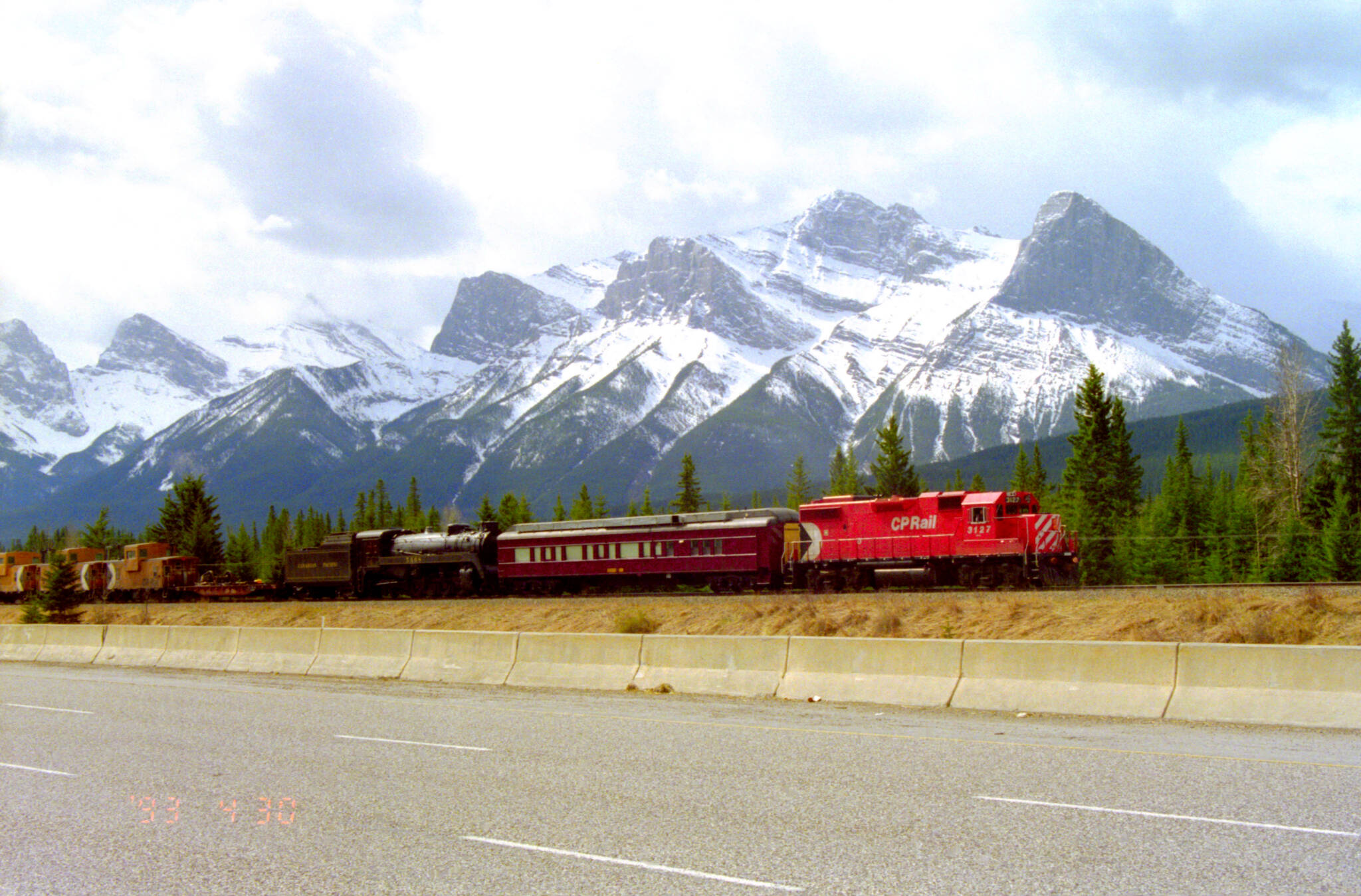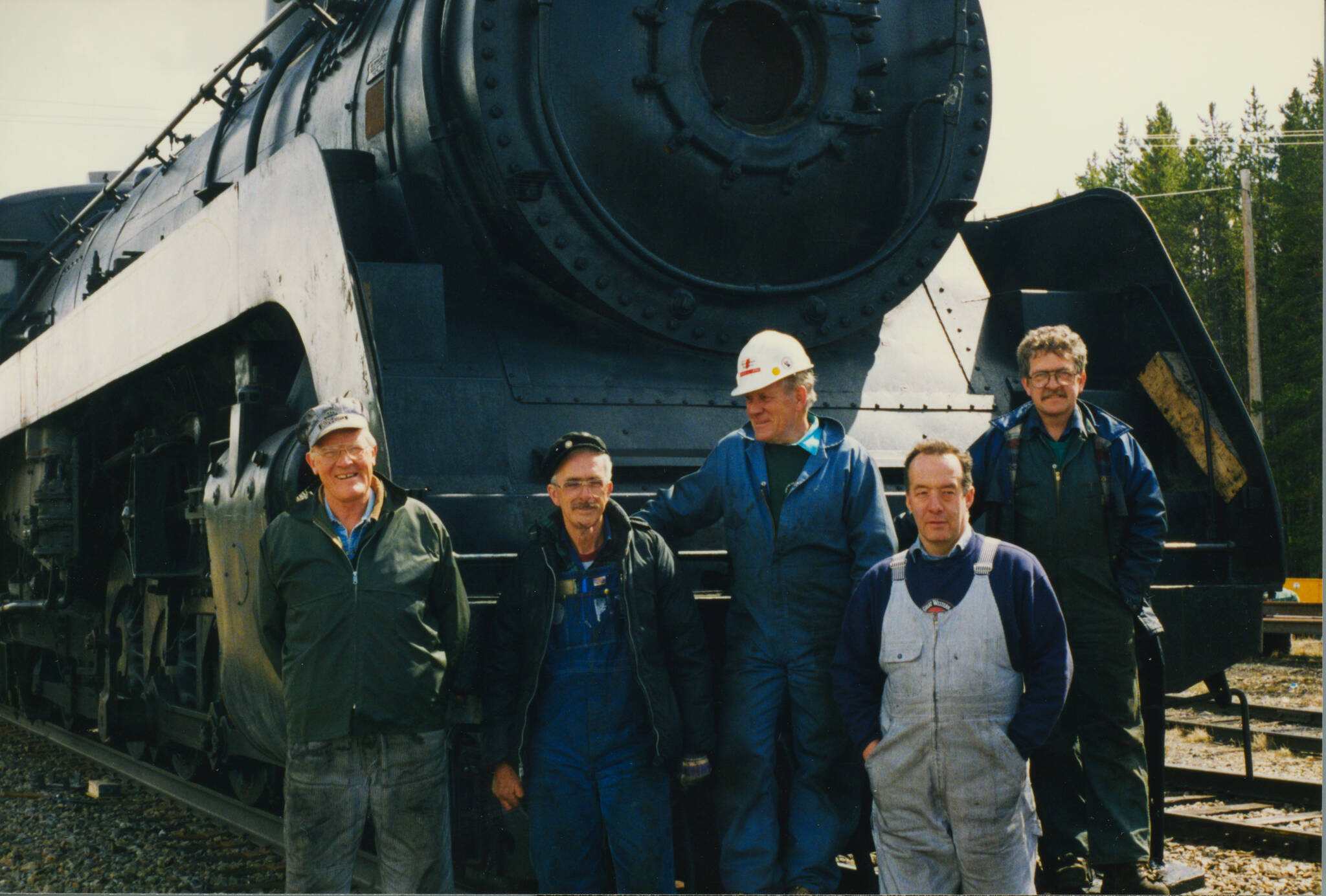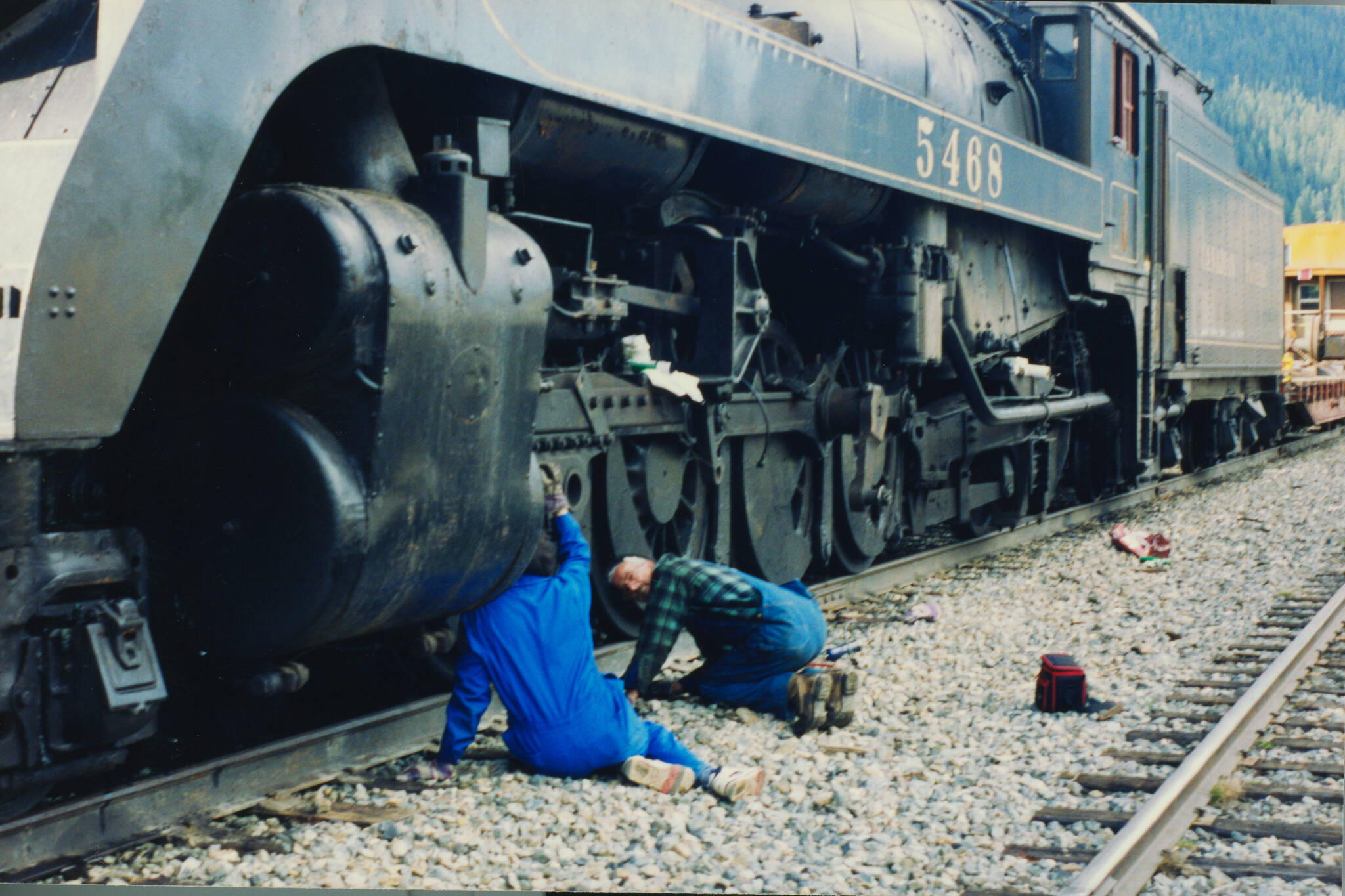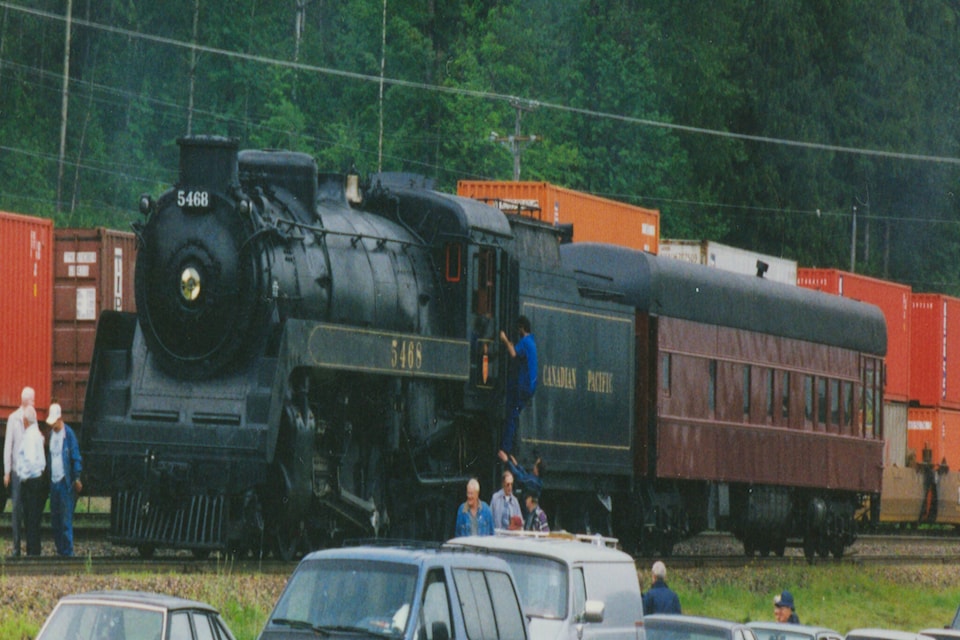The following appeared first in the latest edition of the Revelstoke TIMES magazine, which can be found in local businesses and the Revelstoke Review office.
In September of 1948, the spectacular locomotive blasted a puff of steam as it rolled out into the crisp Autumn air in Quebec, ready to be guided onto whatever runs of wood and steel required its services.
Blocks of brass were forged and welded with fire and steel to create great iron horses, and four numbers were forged into the engine to distinguish one from another. On this September day, on this particular engine, the numbers five, four, six and eight were placed just above the headlamp.
5468 (fifty-four, sixty-eight) was to be stationed at one of North America’s most challenging runs of track.
5468 was heading to Revelstoke.
End of an era for steam
5468 was part of a series of locomotives called ‘The Selkirks’, the biggest locomotives in the commonwealth at the time. It took 10 men to operate them, and they were purpose-built for moving big, heavy cargo through the mountains.
As fate would have it, 5468 was one of the last steam locomotives ever built in Canada. The Canadian Pacific Railway cut off all production of steam engines in 1949, marking an end to the ‘big steam era’.
At the end of their lifetimes in 1956, many steam engines were transferred out of B.C. and onto the safer pastures of the prairies.
But, even there, they would eventually run out of use. Technology had advanced past the use of coal and steam. Diesel engines ushered in a new era of locomotives, trains that could be operated easier and with less manpower. By the 1960s most of the Canadian steam engines had been retired and sent for scrap.
As you may have guessed by now, 5468 escaped the scrapyard. The Revelstoke engine was selected for a collection of Canadian steam locomotives being assembled by the Canadian Railroad Historical Association (CRHA) for display in Montreal, Quebec.
The iron horse was repainted and put on display in Windsor, Ont. before being stricken from the company’s roster in March of 1963 and transferred to the Canadian Railway Museum.
It sat there for the next 30 years.

A conductor and crew
Even the men who helped him move the powerful beast across the country agree, that Ernie Ottewell was the steam that propelled the engine that got the idea of the Railway Museum rolling.
“He lived and breathed steam,” said Revelstoke’s Dean Handley about his old friend. He was a tenacious man with a love for steam engines who ‘kept things humming along’ according to those who knew him.
The year is 1986. Ottewell is nearing the end of his 46-year career on the tracks, which included driving the first full train through the infamous MacDonald Tunnel in Rogers Pass. The legendary engineer was attending a historical steam engine exhibition in Vancouver. He learned of the CRHA’s request to protect six different classes of steam engines. Among those engines: 5468.
The CRHA, alongside Ottewell, decided to turn their eyes towards Revelstoke, a significant location in the history of the Canadian railway because of its proximity to ‘the Last Spike’ amongst other things.
A simple conversation in Vancouver was returned to Revelstoke with Ottewell, and the idea quickly spread like wildfire into the ears of a rail-loving community.
5468 was set to be the centrepiece of the would-be Revelstoke Railway Museum, but it would first have to make the cross-country journey from Montreal to Revelstoke, a seemingly impossible task for some. Not for Ottewell.
Fred Olsson was one of those with a passion for locomotives in his heart. Olsson’s father was a blacksmith for the Canadian Pacific Railway. Although his father urged Fred to stay away from a life on the tracks, this didn’t sway him from a love of model trains.
One night, Ottewell called Olssen up and told him about his idea to get a steam engine to Revelstoke. He was on board.
Before the Canadian Pacific Railway would even think of offering Revelstoke this valuable, unique steam engine, the community had to come together and form a group: the Revelstoke Railway Historical Society. A couple of dozen community members came together, and CP agreed to let them move forward with their crazy would-be plan.
They picked a spot for the museum to be built, hired an architect to design it, and broke ground so that 5468 would have a home to return to when its journey was finished.
Olsson, Handley, Ottewell, Don Hawker and a group of retired railroaders banded together, raised funds, and devised a plan. The biggest hoop to jump through early on in the process was the fact that the steam engine had been sitting dormant for 30 years, and the grease, oil, and lubricant in the engine had long since dried up.
“You couldn’t go to Shell Canada and get a tube of grease,” laughed Olsson.

READ MORE: Revelstoke Snowmobile Club gets new mural
In August of 1992, Ottewell and Olsson arrived in Montreal with a supply of grease borrowed from Scranton, PA, to work on 5468 in an old roundhouse. Olsson said the French Canadians watched on as the two Revelstoke men worked eight hours a day getting this old engine ready. At the end of every day, the pair were covered in grease and grime.
They made their preparations, and the railway set them up to lug 5468 back to Revelstoke on a ‘hospital train’, a locomotive made up of derelict train parts headed to the scrapyard. The train could only travel at a maximum speed of 15 m/ph, making it a true sight to behold for those who saw it passing by and a thorn in the side of fellow engineers.
End of the line
As it turned out, steam engines were incredibly difficult to move, especially after they were saved from the scrap heap. They headed west in late September on their epic journey before trouble occurred.
On Sept. 19, 5468 stopped dead in its tracks in White River, Ontario, a small town nestled on Lake Superior between Thunder Bay and Sault St. Marie. Luckily, White River was home to one of only two drop pits between Vancouver and Montreal, a feature which made it an ideal place to break down if a stem engine was inclined to do so.
Ollson remembers how concerned he was for Ottewell when the engine broke down. The retired engineer put a lot on the line with the ‘big-wigs’ of the Canadian railroad to get this project together, and as he put it: “There’s nothing deader than a dead steam engine”.
Olsson and Ottewell took all the valuables from the train and abandoned 5468 in White River before the start of the winter. “We knew it had to be repaired, but we had no idea how,” said Olsson.
During the winter, CP put 5468 on a flatbed and shipped it to Winnipeg and retrofitted the old engine with the axel from a then-modern diesel engine so that it could get back on the tracks. Olsson said that this turn of events reinforced to him that CP was dedicated to the project.
Back on tracks
In April 1993, Ottewell, Handley, Hawker, and Harry Home returned to White River by train. DON remembers waking up to the snow blowing horizontally off of Lake Superior. They checked out the modifications, performed some test runs, and continued where Ottewell and Olsson left off.
This time, the crew discovered that if they moved just 5 m/ph faster, the grease could get a better coating over the entire axle and it would keep the steam engine from smoking and failing.
When they arrived in Winnipeg, Hawker and Handley remember getting off the train to make a stop at the local Legion to mend their weary spirits. The people there treated them like gods when they heard of the tremendous journey they were on. They fed them, gave them drinks, and all watched the Winnipeg Jets take on the Vancouver Canucks on the TV.

“We just gotta get to 13th crossing,” said Ottewell when the trip neared its end, referring to a crossing on the Illicilewaet River, a location so close to Revelstoke that they could drag it into town if need be.
Finally, they arrived in Revelstoke to a celebration at the platform of the station. Their families welcomed them back with open arms. “Most guys run away to join the circus. We ran away to join the railroad,” laughed Handley.
The old-timers inspected the vehicle before it headed off for the shops. The engine was moved into the newly built museum on a makeshift track made by CP, and the locomotive still sits in that same position today.
30 years of the Revelstoke Railway Museum
Ernie Ottewell passed away peacefully in Revelstoke in 2016. He didn’t want a funeral service and asked for donations to be made to the museum instead of flowers. The passion that Ottewell had for locomotives and the railway is lived on through passionate people like Olsson, Handley, and Hawker, and the stories of the 5468 and so much more are preserved in their landmark museum.
“It’s something to be really proud of,” said Handley about the museum.
The Museum is now a mature institution which is widely recognized as one of the best small railway museums in Canada and the predominant railway museum in the Columbia Mountain region.
The museum has shared this rich rail history with over 500,000 visitors since 5468 rolled into Revelstoke and will continue to remind an ever-changing town of its unique history of life on the railroad.
written by Josh Piercey
READ MORE: Indigenous Friendship Society of Revelstoke to host Every Child Matters Walk
